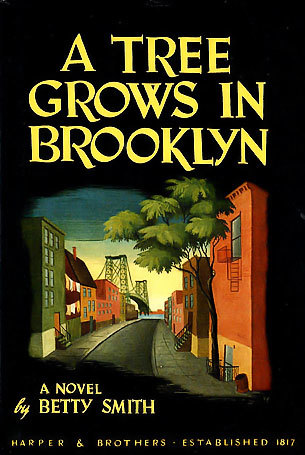“A Tree Grows in Brooklyn”
by Betty Smith

A Tree Grows in Brooklyn, by Betty Smith.
Originally published 1943.
Reviewed by Ed Lengel
Betty Smith, the author of the timeless novel, A Tree Grows in Brooklyn, later reminisced about the origins of this book in a hypothetical conversation with her mother: “It started when I was eight years old. I was playing in one of those Brooklyn streets one sunny afternoon and I saw a group of right-minded housewives throw stones at a mother who wasn’t married. I grew up wanting to protest in some way against intolerance. So, you see, Mama, the beginning of this novel really started when, as a child, I began to notice the world of Brooklyn around me.”
This message of tolerance (and intolerance) resonates throughout this novel of an extended family living on the fringes of society. That alone helps to explain why it remains relevant and relatable. More deeply, however, A Tree Grows in Brooklyn is a simple story of survival. The tree referenced in the title is a type of Asian sumac that grows outside the bedroom of the book’s main protagonist, eleven-year-old Francie Nolan. Where other plants have adapted to the extreme conditions of desert, mountain, or jungle, this tree has accommodated to the harshest environment of all in urban greater New York City. The tree’s durability is symbolic of Betty’s, as she not only endures, but manages to flourish in the midst of adversity, expressing a rare form of internal and external beauty that remains pure, despite all that goes largely unappreciated. Appropriately, this variety of sumac also is known as the Tree of Heaven.
Set initially in 1912 in Brooklyn’s Williamsburg neighborhood, then populated by Irish, German, and other European immigrants from the ongoing great wave of immigration that so transformed American cities in the late nineteenth and early twentieth centuries, A Tree Grows in Brooklyn chronicles the lives of Francie, her younger brother Neeley, and their parents Johnny and Katie. Johnny, an alcoholic, does what he can to earn money here and there as a singing waiter. A subject of mockery for others, he is nevertheless much beloved by Francie, who sees underneath his tortured, clownish veneer to the sensitive and intelligent man he really is. Katie, a tougher love, is the family breadwinner who squirrels away money from her work as a cleaning woman. Where Johnny passes down a dreamers’ vision, Katie imparts a never-say-die determination essential to survival.
Francie’s existence shares nothing in common with the glamorized depictions of poverty common to other young adult literature produced from the distant past until the present day. “Brutalized” by the wretched incompetence, indifference, and cruelty of the public schools, she also endures the casual, hardened cynicism of her peers, who neither receive nor impart compassion in their bitter world. Even the librarian, so often a figure of cliché in lesser novels, despises children and offers no encouragement to Francie as she explores literature, unforgettably perusing shelves from A to Z. Literature nevertheless offers Francie a vital route of escape from the hardships surrounding her.
Literature offers not just escape, however, but a means of grappling with grim reality. When Johnny dies as a direct result of his alcoholism (and inability to grapple with the world as it is), Francie captures her yearning and heartbreak in an essay about her father that she presents in school. Horrified, her teacher tells Francie to destroy the essay and write instead about the “true nobility of man,” but the girl recognizes that truth resides in what she has written, rather than in some abstract concept and remains faithful to the memory of her father even though his life earnings suffice only to purchase his burial plot.
Continuing through the United States’ participation in World War I, which profoundly changes life for Francie and her family while also forming a Rubicon between prewar and postwar American life, A Tree Grows in Brooklyn brings Francie from youth to a trembling perch upon the brim of adulthood. Nothing about the journey is artificial, neither in tragedy nor uplift. This remains so even though Francie tells Neely at the conclusion of the book that the Brooklyn of their youth is “a magic city and it isn’t real…. It’s like—yes—a dream. . .. But it’s like a dream of being poor and fighting.” That a tree can grow in a place like the Brooklyn of Francie’s—and Betty Smith’s—youth is in itself magical. An era that speaks so much, but understands so little, of adversity would do well to emulate its example.
Ed Lengel is an author, a speaker, and a storyteller.




